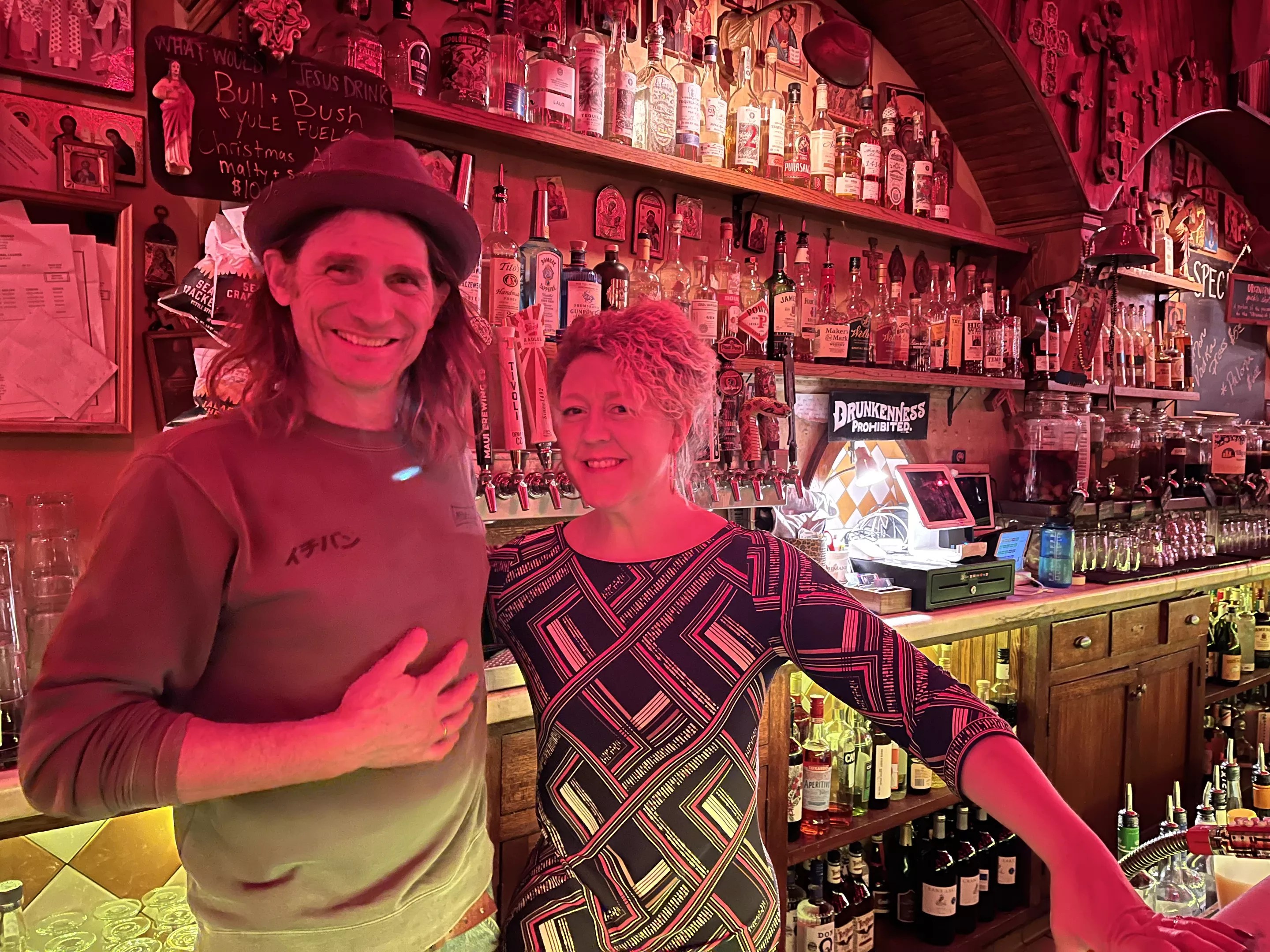
Tony White

Audio By Carbonatix
We all love our favorite old Denver bars and restaurants for their enduring, lovable presence. In Old Standards, we sit down with the people behind some of the city’s classic joints to explore their storied pasts while looking forward to the modern era. Will adaptation be the road to ruin? Or is comforting consistency the path to survival for these steadfast anchors in a city whirling with reinvention?
Born on January 24, 2001, at 2015 East 17th Avenue, the Thin Man is an Aquarian golden snake of the new moon.
Since it opened, the Uptown bar has defied simple definitions, but the characteristics of its zodiac and Chinese calendar signs illuminate some noteworthy parts of its personality and the people often found within its walls.
Aquarians are independent and original, assertive yet easygoing. The Thin Man’s opening fell on the first day of the lunar new year of the golden snake, assigning attributes of intelligence, wisdom and creativity, and the bar embodies all of these traits – plus a few that are harder to articulate.
This year, make your gift count –
Invest in local news that matters.
Our work is funded by readers like you who make voluntary gifts because they value our work and want to see it continue. Make a contribution today to help us reach our $50,000 goal!
On a recent frigid Friday night, I stepped into its cozy corridor and was enveloped in a warm glow of red light beaming from the garland of bulbs strung across the bar’s ceiling. An ’80s alternative mix of Siouxsie and the Banshees and the B-52s blasted from the sound system over a lively crowd of puffy-jacketed and Carhartt-clad young professionals.
Laid-back regulars congregated at the end of the bar, while newcomers took in the interior decor, scanning one wall running the length of the entire room covered in a mosaic of gold-framed portraits of Jesus and old-world saints.
The Thin Man emanates a strong gravitational pull from its location on a darkened strand of blocks between Colfax, Uptown and City Park, drawing in drinkers from near and far.
One patron, Jordan, has lived in Fort Collins for four years. He came to the Thin Man for the first time last year on the invitation of a friend, and was enamored enough with it to make the drive back, bringing a friend of his own this time. “It’s a wonderful place to crash into another human being and have a conversation,” he says. “It’s undeniable. There’s something about the place.”
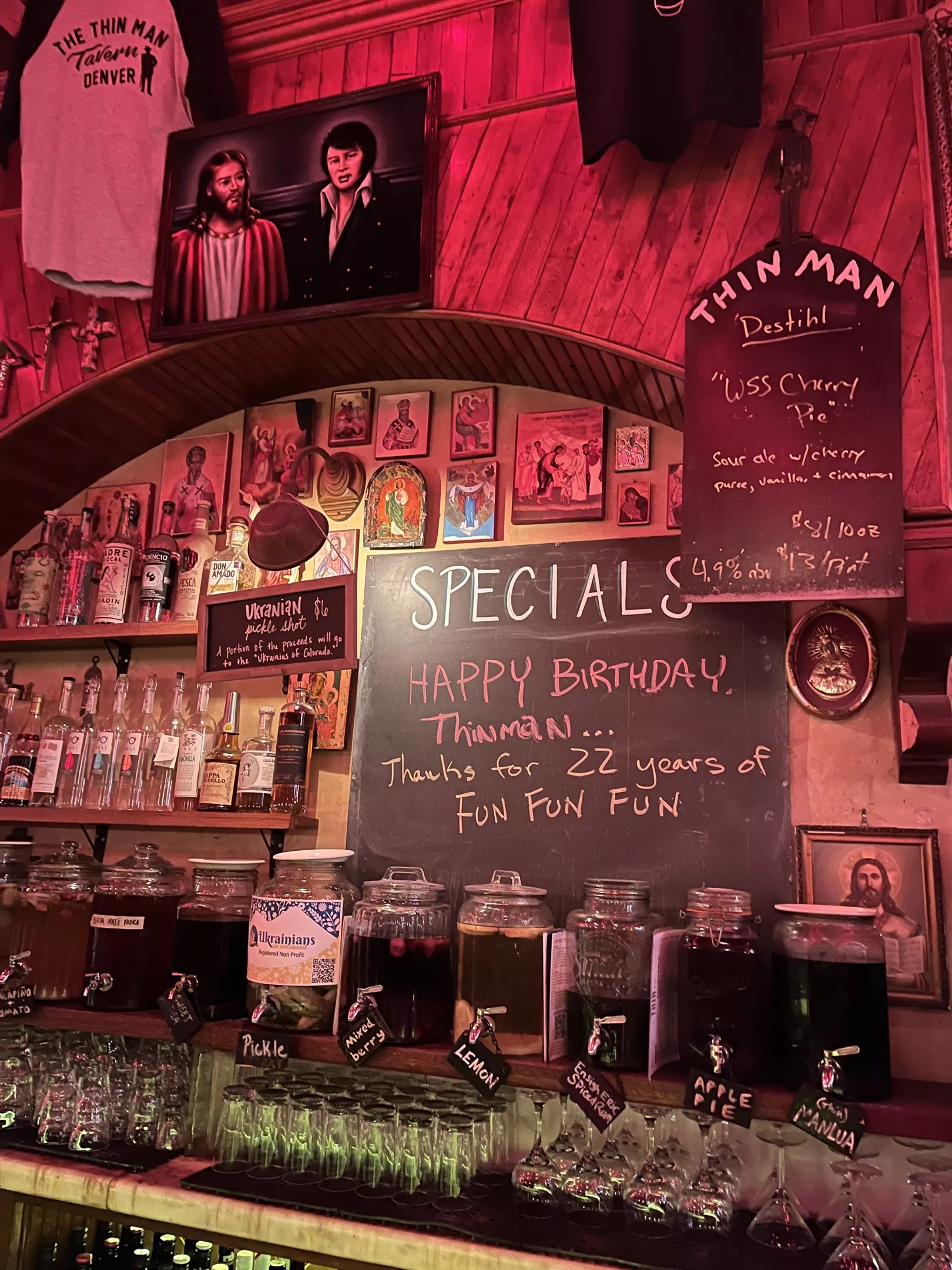
The Thin Man recently turned 22.
Tony White
“I think we have a pretty diverse crowd, although lately it seems like it’s getting younger. But I’m getting older,” admits owner Eric Alstad.
Before launching the Thin Man 22 years ago, Alstad and his wife, Christina Pappas, opened St. Mark’s Coffeehouse next door in 1996, after moving it from its original location downtown near the corner of 14th and Market streets. The couple refinanced their home to purchase the entire building, which extends west from their coffee shop along the alley to the corner of 17th Avenue and Race Street.
They were hesitant to open a drinking establishment at first – Pappas thought a bar brought too much liability, Alstad thought too much sin. He consulted his priest for advice, who gave him the blessing, saying it would be an honorable tavern because Christian icons would hang on its walls. “People think it’s ironic, but it really isn’t. I’m Greek Orthodox, and I am a believer. I think it helps us. I think we’ve had maybe one or two fights in 22 years. I try to make it a place where it is not that kind of place,” Alstad explains.
In early 2000, he found a collection of thick-cut white Italian marble slabs in a local salvage yard and was struck with inspiration. “This will be the bar top,” he recalls thinking. Pappas told him to buy it all, and buy it now. He did, and construction began.
A few weeks later, Alstad was laying out the bar’s floor plan with his buddy Larry. Tape measure in hand, Alstad noticed a problem: “I said, ‘You know, Larry? I’m not going to be able to fit booths in here. This place is too fucking thin, man!'”
Alas, the bar would have no booths, but it did have a name.
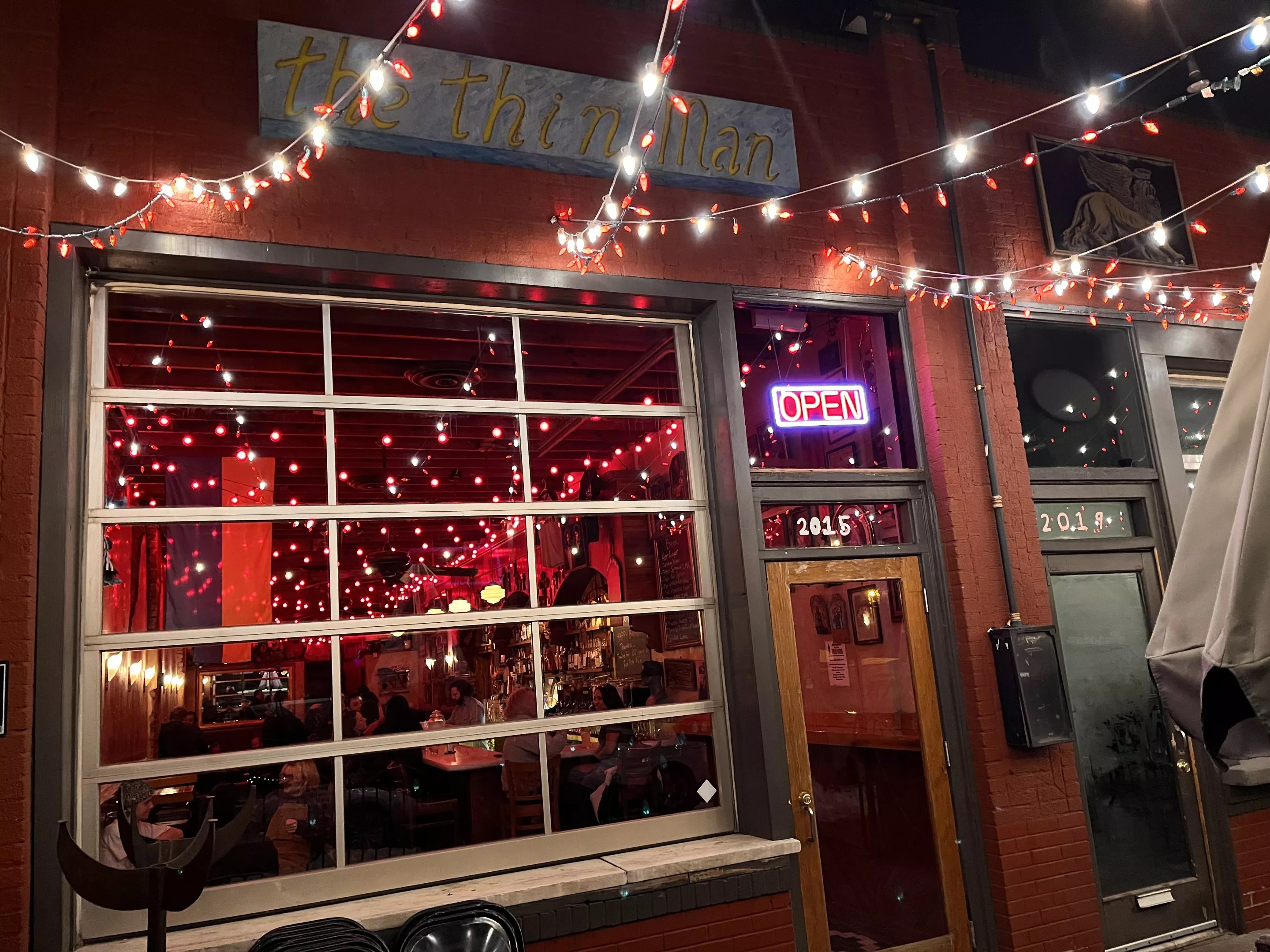
The bar was too thin, man, for booths.
Tony White
Alstad taped a sign on the bar’s front door saying opening day would be on Super Bowl Sunday, but the game wouldn’t be on; the Thin Man has never had TVs, and Alstad says it never will.
“I wanted it to be a place where people can converse with each other and with strangers. It’s not a sports bar; it’s an everyone bar,” he explains. “It’s special, because the kind of people who are attracted to it are a little different. I always called it ‘the Ship of Nerds.’ The people who come here are maybe just a hair more thoughtful than the average person.”
The Thin Man is a bar for everyone, but not just anyone works behind the bar. Steph Cook has been bartending here for two decades. With a sweet demeanor laced with seasoned professionalism, she greets a couple with, “Hey there! What are we drinking tonight?” before sliding down to me and my empty gin and tonic, asking, “Can I fill that baby up for ya?” She looks over my shoulder to a guy behind me wanting to order a round of drinks for his table. “Everyone in your group has an ID?” Cook asks.
For her, the Thin Man has become much more than a job, and the people more than just guests. “It’s been like a family to me,” she says. “I feel so thankful for the regulars. They’re like a family to everyone there.”
The Thin Man has cultivated a genuine sense of community for a lot of folks over the years, Cook adds: “It’s truly a lot of people’s family. That’s my number-one thing. It’s their safe space. It truly is their family and social outlet.”
The bar has long possessed a socially conscious aspect, as well. From the two large Ukrainian flags hung from the rafters to the fundraising contributions made with each purchase of its Ukrainian pickle shots, the Thin Man wants to be connected to global matters as much as local causes.
Along the rear wall, between the Christian kitsch and velvet Christ paintings, hangs a long and growing list of handwritten names in black ink on white paper running down the wall. Each person cited was killed by police in this country. The first name on the list is George Floyd. The latest is Tyre Nichols.
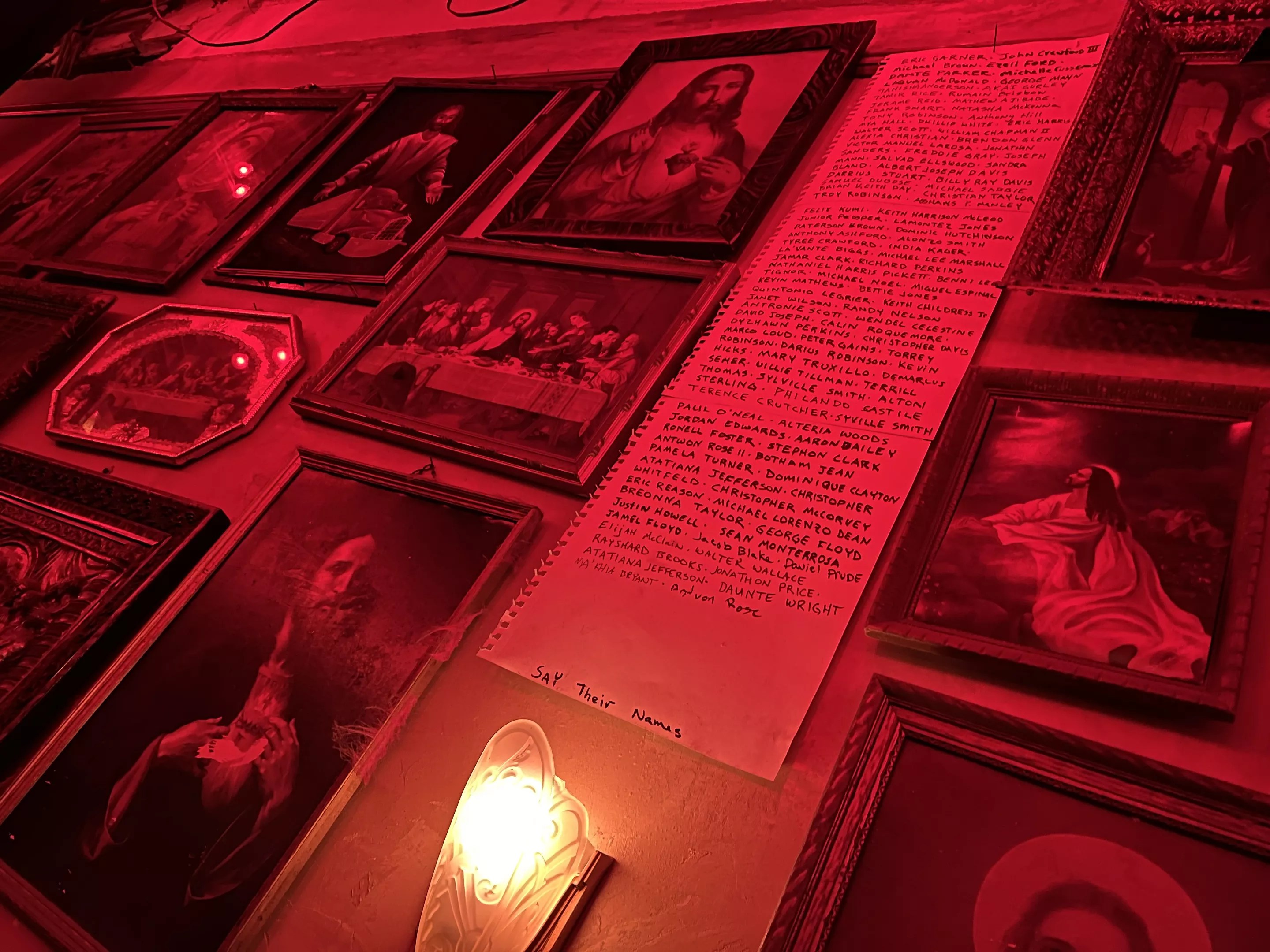
“Say their names.”
Tony White
“We have a public presence, whether we like it or not. I try not to be very blatant about my politics, but I don’t hide them. We just try to be a place where there’s a different-mindedness than what is maybe being pushed at us by our government,” Alstad says.
It’s a fun-time bar, nonetheless, with the self-awareness to have a cheeky margarita on its cocktail list called the Spicy Jesus. It also serves a wonderful rendition of a mezcal negroni, plus a dozen or so craft beers on draft.
There is a timelessness to the Thin Man. The pillared back bar is capped with hardwood panel arches festooned with crucifixes and lined with bottles of booze, glass jugs of vodka infusions and a hand-painted sign reading “Drunkenness Prohibited” that hangs above the digital tablet station serving as the register. This is the only modern element that gives away the fact that you’re not actually drinking in a 1930s Eastern European mountain chalet decorated by an estranged Vatican interior designer.
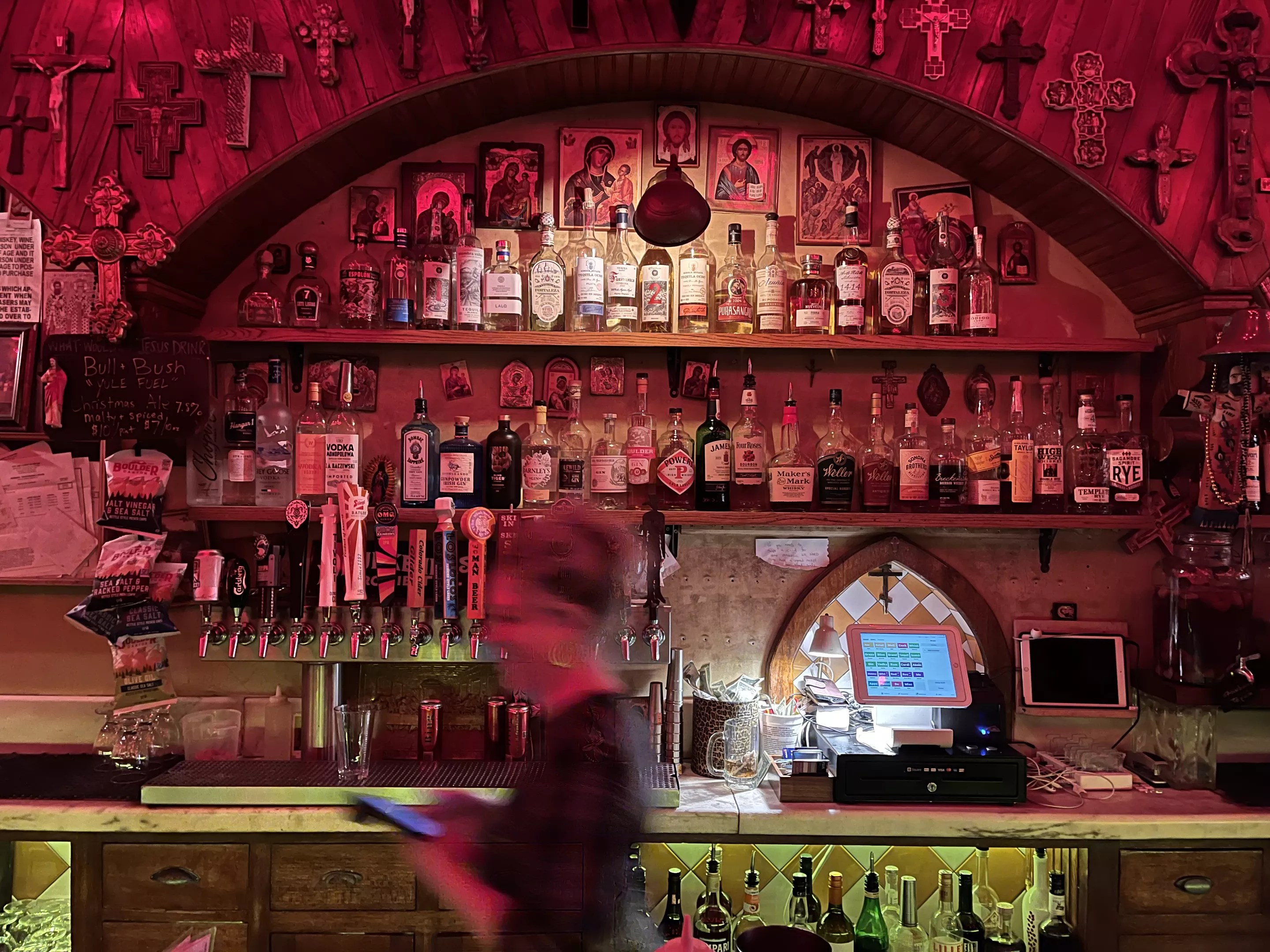
The Thin Man was built to last 100 years.
Tony White
The Thin Man continues to be both irreverent and relevant, changing little of its look and feel over the years. Cook credits the bar’s enduring presence to staying true to its original vision of being a gathering place for neighbors and good conversation. She says it’s become a “multi-generational space” now, with longtime regulars bringing their kids into the bar or the cafe. “I hear it all the time. People always come back to visit and say, ‘It’s still the same,'” she notes. “That’s the thing about the Thin Man. We’ve never tried to fit in. It’s just been the little awkward bar that could.”
For this bar, consistency has been embraced as a mantra and a decree. It’s a place holding fast to itself. Alstad says he built the Thin Man to last 100 years. He’s two decades and two years into the goal, and it seems as sturdy and beloved as ever.
“It’s like a place you can touch, like you’re back where you know you have a safe kind of memory,” he concludes. “When I build things, I like to build them with materials that are special. I think we got it right, right off the bat. It’s more broken-in now. It’s more used. There’s more history, more scratches and dents. It’s not new, it’s used. It’s aging well.”